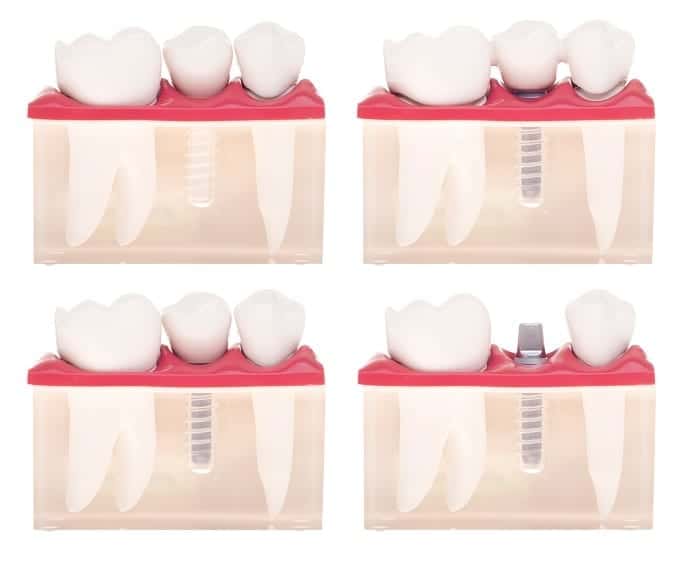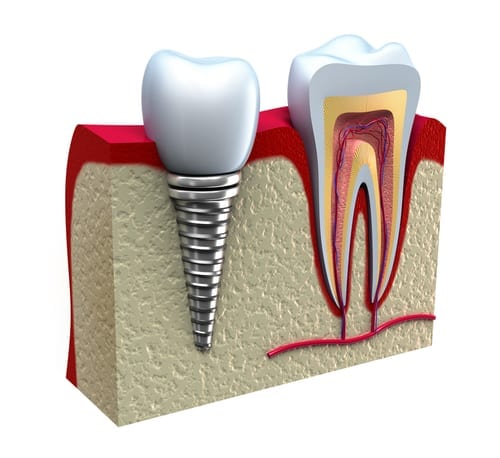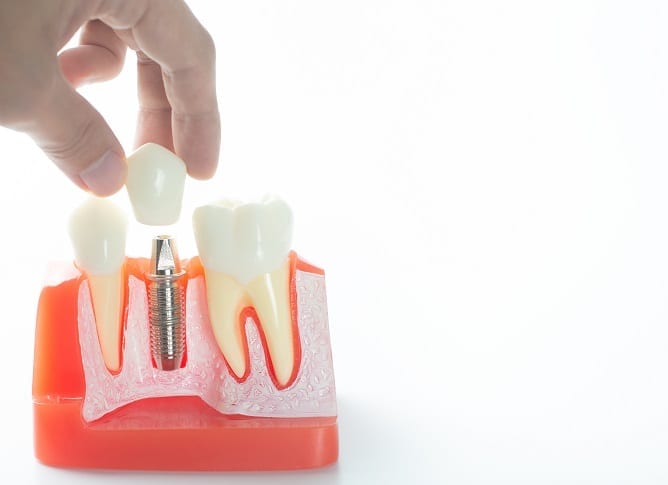Dental implants are synthetic tooth roots that connect the false tooth crown or bridge to your jaw in order to better simulate natural teeth. It’s a frame or metal post that’s surgically positioned into the jawbone right beneath your gums. This entails cutting through the gums and drilling through the bone in order to screw the post there before the gums are stitched up and allowed to heal. Once everything is fully healed, then the dentist will screw in the crown or bridge plus abutment.
Once they’ve been put into place, they enable your crown to get mounted and your missing teeth to get replaced with amazing results. Unlike removable false teeth, the dental implant is more permanent and stable. It allows your crown to work and appear like a normal natural tooth by using the implant as its tooth root anchor.
Page Contents
How Do Dental Implants Work?
Implants fuse to your jawbone, thus providing a stable support or foundation for your artificial teeth or dentures, whether they’re crowns or bridges. Once your dental prosthodontics are mounted unto your implant or implants, they won’t shift or slip into your mouth. Implants are quite expensive compared to teeth extraction or a root canal treatment that allows you to preserve the original tooth while removing the infected tooth root instead.
- Eating and Speaking: The most common issue people have with removable dentures aside from hygiene concerns is how unstable they can get. Some have even ended up swallowing or choking on their dentures accidentally. It’s important to have implants because they allow your prosthetic teeth to be stable enough to use for eating and speaking.
- Secure Fit: Implants are further characterized by how bridges and dentures tend to have a secure fit over them with the assistance of fillers known as abutment. This results in a hard base that’s not easy to dislodge, kind of like a natural tooth with a root that’s linked deep into the socket of the jawbone. You can put in All-on-4, All-on-6, or All-on-8 dental implants to replace someone’s teeth after he had lost all of them, with him only left with gums. They feel more natural than conventional dentures or bridges to boot.
- More Comfortable Than Uncomfortable Dentures: There are some people who are simply uncomfortable with ordinary removable dentures and bridges that require you to chisel healthy teeth to turn them into anchors or abutments for the prosthetic crowns. Some might induce things like gagging, poor ridges, and sore spots. Your gums might also end up infected or allergic to the metal, leading to swelling and irritation. Ordinary bridges also tend to necessitate destroying the tooth or teeth on either side of the missing tooth or teeth.
- The Implant Advantage: Additionally, implants have the advantage of not needing adjacent teeth to anchor the bridge, crown, or denture. Because of its natural feel, you’re less likely to get irritated gums or gag reflex from them. Your mouth will easily accept the prosthodontics better and will get used to it more easily. Your dentist won’t have to ground or prepare adjacent teeth to hold your new false tooth or teeth into place. The major downside to this is obviously the need to cut open your gums and access the jawbone, which takes weeks to months to fully heal.
- Requirements: Not everyone can receive implants. You need to have adequate jawbone mass and support as well as healthy gums in order to become a viable candidate for dental implantation surgery. If not, you can get it later once you’ve healed your gums and have bone grafting surgery that grafts more bone on top of your jaw so that there’s more bone available to fuse with the implant. Keeping your gums and bones healthy also requires regular dental visits and meticulous oral hygiene. This is also called for when it comes to ensuring the long-term success of your dental implant.
The main reason why dental implants aren’t as common as dental extractions and root canal therapy is because it’s infamously expensive compared to other tooth replacement options. Also, most insurance companies cover only less than 10 percent of the price of an implant. The rest you have to pay for out of pocket.
Metal versus Non-Metal Implant Materials

Throughout the years, the materials used for dental treatments such as implant surgery were mostly metallic in nature. This is because metal is known to be sturdy and long-lasting. The mechanical strength of metal can withstand the constant bite forces of your mouth, particularly the molar or back tooth portion of your bite. Metal also augments the dental implant’s longevity.
As science marched on, research has enormously contributed to improved mechanical strength of ceramic materials. At the start, ceramics were introduced into dental treatments because of their superior aesthetics to metal options. However, further discoveries about the material showed that aesthetics isn’t its only beneficial property. Ceramics are also non-allergic, non-corrosive, and inert, making them many more times beneficial to dental implant longevity and patient health.
The Introduction of Zirconia in Dentistry
Zirconia is different from earlier forms of all-ceramic restorations. It’s not only used in implant dentistry due to its comparative toughness to metal implants. It’s also used for teeth due to its combination of form and function or excellent dental aesthetics that match the original teeth coupled with superior strength compared to other types of all-ceramic prosthodontics.
- Biomedical Properties: After the Swedish chemist Jöns Jakob Berzelius first isolated zirconia, it took about 150 years before it was considered for usage in biomedical applications. It was Helmer and Driskell who published that scientific study of zirconia’s medical viability back in 1969. Afterwards, in 1972, Garvie and Nicholson discovered that alloying zirconia with oxides like magnesia, yttria, and calcia could stabilize its tetragonal modification, which long story short helped produce ceramics with notable crack resistance needed for dental restorations.
- Dental Implant Advancements Through Zirconia: In the 1980s, the metal dental implant used to only have two parts—the abutment where the prosthetic crown is placed and cemented and the fixture or post that’s screwed then fused right into the jawbone. The emergence and experimentation of zirconia for dental purposes made it possible for an abutment to be part of the fixture as one whole implant piece in the 2000s. Additionally, zirconia made it possible for the abutment to be made of remarkably tough ceramic. This material is notable for its tissue-friendliness. It’s not as gum irritating as titanium.
- One-Piece Zirconia Implants: By 2005, full ceramic implants made of zirconia were introduced to Europe. They combined the abutment and fixture together for form, function, aesthetic, and health purposes. By 2011, the FDA approved use of these zirconia implants in all the clinics in the U.S.A. The main claim to fame of this implant type is that it has no prosthetic connections that can serve as a Petri dish of bacterial growth. Your gum health is assured by using zirconia implants as your titanium implant alternative.
- Metal Allergy: There are a percentage of patients who have metal allergy and cannot take having metal fused to their bone as part of an implant procedure. All-ceramic or zirconia implants serve as the alternative to titanium implants and even metal dental restorations. Its dental applications are myriad, thusly including things like zirconia dental implants and abutments, crowns and bridges, and dental posts, among other restoration options.
- Zirconia Dental Implants and Abutments: Dental implants and abutments made of zirconia offer a metal-free solution for patients who are sensitive to metal or worry about the bacterial infection risk of such materials. Abutments match the color of the teeth because zirconia can be any color you want or need. What’s more, the bio-inert material exhibits good tissue compatibility with your mouth and low accumulation of plaque when compared to their titanium counterparts.
What Are Zirconia Implants?
In regards to zirconia implants in particular, it’s a non-metallic or metal-free treatment that makes use of cubic zirconia (CZ), which is a form of zirconium dioxide that’s cubic crystalline in composition. This material is synthetic and known for how colorless and hard it is. It can also be made in a variety of colors, such as tooth colored. With that said, here’s what zirconia implants bring to the table compared to their titanium counterparts.
| ZIRCONIA IMPLANTS | TITANIUM IMPLANTS |
|---|---|
| Easier to Maintain: Zirconia implants are easier to maintain and clean because their restorative margin is at the gum level, which can be reached by the toothbrush and floss.Colored Like Tooth Roots: Zirconia implants have a white or tooth color to them, which is identical to natural teeth. This means they won’t peek out of the gumline like metal-colored implants would (gum discoloration).Bio-Inert and Corrosion-Free: Ceramic materials like zirconia allows your gums to be healthier and better preserved. The material doesn’t corrode like metal and it’s ultimately bio-inert or won’t cause infection.One-Piece Design: You don’t need sub-gingival connections with the way zirconia implants are designed in a one-piece fashion. This fact prevents bacterial infection as well.No Bleeding and Inflammation Risk: It’s quite rare for you to end up bleeding or getting an infection when you have a zirconia implant placed on your mouth. Ceramics are cleaner than metals in more ways than one. | Bacterial Risk: A titanium implant’s margin is at the bone level, which means bacteria could seep into places where your toothbrush couldn’t reach. It can’t go any lower for cleanup.Poor Gum Aesthetics: The metal appearance of titanium thusly requires the placement of the post deep into the gum to hide the gray color of the metal. It’s also done to avoid gum discoloration and poor aesthetics.Corrosion and Infection Issues: Bacteria can accumulate much faster in metal surfaces. Also, metals are more difficult to clean. Oxidation and corrosion is an unavoidable reality of metal as well.Two-Piece Design: Standard titanium implants can end up with bacteria and liquids like pus to penetrate between the two parts, resulting in infection and halitosis (bad breath).Receding and Inflamed Gums: You can end up with bleeding, inflamed, or even receding gums by going the titanium implants route. You’re likelier to have gums bleed due to these implants versus zirconia ones. |
The main differences between zirconia implants and titanium implants root from the facts that titanium is metal and vulnerable to corrosion while zirconia is a bio-inert ceramic material that isn’t likely to cause allergies or infections. It also comes in one piece to keep the material from gathering food pieces that rot and feed bacteria, which in turn will cause gum inflammation, gingivitis, or even outright periodontal disease of the surrounding teeth.
The Dangers of Corrosion from Metal Implants

Corrosion is the gradual degradation of materials like metal by electrochemical attack. It’s the primary concern that patients and dentists have of using metal implants, even when military-grade titanium metal is used for it. Any metallic implant can corrode when placed in a hostile electrolytic environment offered by the human body, specifically the mouth. Corrosion is also defined by the interactive process between a chemical environment and a solid material.
The solid material corrodes or losses substance from its material as it undergoes changes in its structural properties. Its structural integrity can also be compromised due to its interaction with the electrolytic environment. There are real consequences to be had from a metal implant corroding and wearing down, particularly on the surrounding gum and bone tissue. At worst, your corroded titanium implant could outright cause periprosthetic bone loss.
There are even authors reporting increased concentrations of systemic and local trace metal associated with having metal implants. That’s why there’s been a shift in using metal implants to ceramic ones like zirconia implants. Those implants are simply safer and healthier in the long run.
Conclusion
Zirconia dental implants are high-quality implants that serve as a great substitute to titanium implants in terms of cost and effectiveness. This material doesn’t have issues when it comes to corrosion like metal implants do. Additionally, if your body is allergic to having metal surgically infused to your bone then you can go the zirconia route as your alternative implant option. Additionally, the white color of the implant allows your gums to remain pink and identical to their appearance with natural teeth roots. Metal titanium implants tend to discolor the gum surface somewhat, especially if you have thin gums.
Thantakit International Dental Center is Thailand’s longest established dental center. Situated in Bangkok, our clinic is renowned across the world as a destination for world-class dentistry, including Zirconia Dental Implants, with most of our patients flying to us from Australia.
Please contact us today and get a FREE dental consultation.












